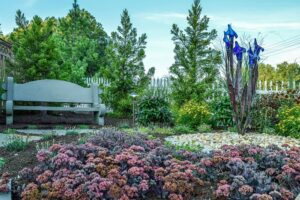
Let’s explore how you can incorporate color into your landscaping.
Homeowners are constantly seeking innovative yet simple methods to enhance the beauty and functionality of their outdoor spaces. One of the most effective ways to dramatically transform your landscape is by using dynamic landscape materials to add color and dimension to your garden. These elements can redefine your garden’s aesthetics, improve soil health, and create a sustainable landscape. Let’s explore how you can incorporate color into your landscaping.
The Importance of Balancing Colors in Your Landscape
When using color in your landscaping, you must consider something called “color harmony.” This is the idea that colors should be arranged in a visually appealing way. Color harmony creates both balance and appeal. This means avoiding any extreme color variation. For instance, you likely would not want a dozen different color variations. This will look too busy or even “messy” to the eye. Too much visual stimulation from excessive variety can feel chaotic and unpleasant. Rather than having a whole mix of different colors together, it’s better to have large groups of individual colors collectively planted together.
Use Colored Mulches to Spruce Up Flower Beds
Dyed mulch has grown in popularity recently due to its customizable nature. This allows homeowners to match the color of their mulch to the rest of the landscape. Different color mulches provide different benefits depending on the type of mulch, the color used, and the type of plants being grown.
Black mulch absorbs and retains heat, making it beneficial for use in cooler climates or early planting. The dark color also suppresses weed growth by blocking sunlight, effectively preventing weeds in vegetable gardens or landscaped areas. Black mulch can also enhance the aesthetic appearance of garden beds, providing a clean and polished look.
Brown mulch is a popular natural-looking mulch option. It can provide good insulation for plant roots, helping to regulate soil temperature and moisture levels. Brown mulch also suppresses weed growth by blocking sunlight, although due to its lighter color, it may not be as effective as black mulch.
Red mulch is often made from recycled wood or dyed with a red colorant. It is known for its vibrant color, which can add visual interest and contrast to garden beds. Due to its color and scent, red mulch has also been reported to repel some insect pests, such as whiteflies.
Use Decorative Stone for Consistent Color Schemes
Whether your garden’s theme is Zen, tropical, cottage, or minimalist, decorative stone can be adapted to enhance its overall look and feel. Consider using light-colored fine gravel or sand for a calming, raked feature for a Zen garden. Tropical gardens benefit from larger, colorful stones and rich, dark mulch highlighting vibrant plants. Cottage gardens come to life with winding, multi-colored stone paths and flower beds. At the same time, minimalist landscapes benefit from the clean lines of geometric stone designs.
Questions? Lehnhoff’s Supply is Here to Help
If you still have more questions about incorporating color into your landscape, the trained professionals at Lehnhoff’s Supply are here to help you.
Find us at 2708 Belair Road, Fallston, MD 21047 and give us a call at 410-510-7646. For tips, tricks, and to see what we have been up to, be sure to follow us on Facebook, X – Twitter, and Pinterest!
We serve but aren’t limited to, the following parts of Maryland: Harford County – Fallston, Forest Hill, Joppa, Edgewood, Bel Air, Churchville, Havre de Grace, Jarrettsville, Street, Aberdeen, Abingdon, and Joppatowne. In Baltimore County: Kingsville, Perry Hall, Overlea, Fullerton, Nottingham, Parkville, Towson, Carney, Loch Raven, Lutherville, Timonium, Hunt Valley, Cockeysville, Sparks, Glyndon, Pikesville, Reisterstown, Ruxton, Parkton, Glen Arm, Baldwin, Monkton, Long Green, White Marsh, Rosedale, Phoenix, and Fork.
